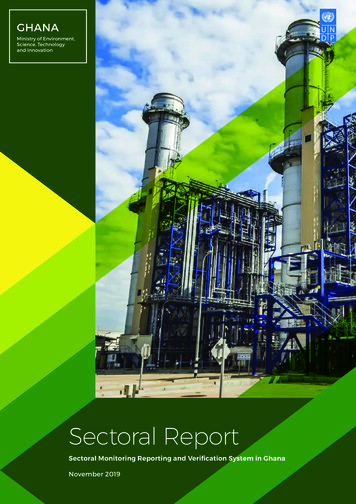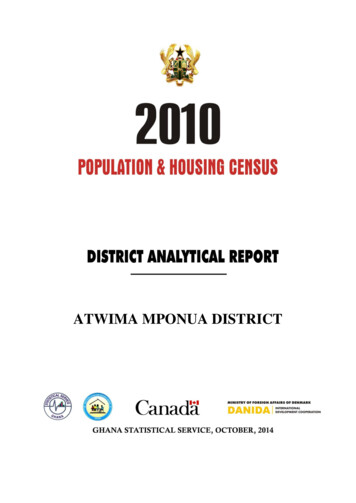
Transcription
ATWIMA MPONUA DISTRICT
Copyright @ 2013 Ghana Statistical Serviceii
PREFACE AND ACKNOWLEDGEMENTNo meaningful developmental activity can be undertaken without taking into account thecharacteristics of the population for whom the activity is targeted. The size of the populationand its spatial distribution, growth and change over time, in addition to its socio-economiccharacteristics are all important in development planning.A population census is the most important source of data on the size, composition, growthand distribution of a country’s population at the national and sub-national levels. Data fromthe 2010 Population and Housing Census (PHC) will serve as reference for equitabledistribution of national resources and government services, including the allocation ofgovernment funds among various regions, districts and other sub-national populations toeducation, health and other social services.The Ghana Statistical Service (GSS) is delighted to provide data users, especially theMetropolitan, Municipal and District Assemblies, with district-level analytical reports basedon the 2010 PHC data to facilitate their planning and decision-making.The District Analytical Report for the Atwima Mponua District is one of the 216 districtcensus reports aimed at making data available to planners and decision makers at the districtlevel. In addition to presenting the district profile, the report discusses the social andeconomic dimensions of demographic variables and their implications for policy formulation,planning and interventions. The conclusions and recommendations drawn from the districtreport are expected to serve as a basis for improving the quality of life of Ghanaians throughevidence-based decision-making, monitoring and evaluation of developmental goals andintervention programmes.For ease of accessibility to the census data, the district report and other census reportsproduced by the GSS will be disseminated widely in both print and electronic formats. Thereport will also be posted on the GSS website: www.statsghana.gov.gh.The GSS wishes to express its profound gratitude to the Government of Ghana for providingthe required resources for the conduct of the 2010 PHC. While appreciating the contributionof our Development Partners (DPs) towards the successful implementation of the Census, wewish to specifically acknowledge the Department for Foreign Affairs, Trade andDevelopment (DFATD) formerly the Canadian International Development Agency (CIDA)and the Danish International Development Agency (DANIDA) for providing resources forthe preparation of all the 216 district reports. Our gratitude also goes to the Metropolitan,Municipal and District Assemblies, the Ministry of Local Government, Consultant Guides,Consultant Editors, Project Steering Committee members and their respective institutions fortheir invaluable support during the report writing exercise. Finally, we wish to thank all thereport writers, including the GSS staff who contributed to the preparation of the reports, fortheir dedication and diligence in ensuring the timely and successful completion of the districtcensus reports.Dr. Philomena NyarkoGovernment Statisticianiii
TABLE OF CONTENTSPREFACE AND ACKNOWLEDGEMENT . iiiLIST OF TABLES . viLIST OF FIGURES . viiiACRONYMS AND ABBREVIATIONS . ixEXECUTIVE SUMMARY . xiCHAPTER ONE: INTRODUCTION . 11.1 Background . 11.2 Physical Features . 11.3 Political Administration . 21.4 Social and Cultural Structure . 41.5 Economy . 51.6 Census Methodology, Concepts and Definitions . 51.7 Organization of the report . 15CHAPTER TWO: DEMOGRAPHIC CHARACTERISTICS. 162.1 Introduction . 162.2 Population Size and Distribution . 162.3 Age-Sex Structure . 172.4 Fertility, Mortality and Migration . 19CHAPTER THREE: SOCIAL CHARACTERISTICS . 253.1 Introduction . 253.2 Household Size, Composition and Headship . 253.3 Marital Status . 273.4 Nationality. 323.5 Religious Affiliation . 333.6 Literacy and Education . 34CHAPTER FOUR: ECONOMIC CHARACTERISTICS . 394.1 Introduction . 394.2 Economic Activity Status . 394.3 Occupation . 424.4 Industry . 424.5 Employment Status . 444.6 Employment Sector . 44CHAPTER FIVE: INFORMATION COMMUNICATION TECHNOLOGY . 465.1 Introduction . 465.2 Ownership of Mobile Phones. 465.3 Use of Internet. 465.4 Household ownership of desktop or laptop computer . 47CHAPTER SIX: DISABILITY . 486.1 Introduction . 486.2 Population with Disability . 486.3 Type of Disability . 48iv
6.4 Distribution of disability by type of locality . 496.5 Disability and activity status . 506.6 Disability and educational level attainment . 51CHAPTER SEVEN: AGRICULTURAL ACTIVITIES . 537.1 Introduction . 537.2 Households in agriculture . 537.3 Types of farming activities . 53CHAPTER EIGHT: HOUSING CONDITIONS . 568.1 Introduction . 568.2 Housing Stock . 568.3 Type of Dwelling and ownership status. 578.4 Construction Materials . 598.5 Room Occupancy . 628.6 Access to Utilities and Household Facilities . 628.7 Source of water for drinking and for other domestic use. 658.8 Bathing and Toilet Facilities . 668.9 Method of Waste Disposal . 68CHAPTER NINE: SUMMARY OF FINDINGS, CONCLUSIONS AND POLICY9.19.29.39.4IMPLICATIONS . 70Introduction . 70Summary of Findings . 70Conclusions . 72Policy Implications . 72REFERENCES . 74APPENDICES . 76LIST OF CONTRIBUTORS . 81v
LIST OF TABLESTable 2.1: Population Characteristics, 2000-2010 . 16Table 2.2: Population by age, sex and type of locality . 17Table 2.3: Reported total fertility rate, general fertility rate and crude birth rate. 19Table 2.4: Female population 12 years and older by age, children ever born, childrensurviving and sex of child . 20Table 2.5: Total population, deaths in households and crude death rate by district . 21Table 2.6: Total Population, deaths in households, cause of death and crude death rate . 22Table 2.7: Age at death by sex of deceased person in the district . 23Table 2.8: Birthplace by duration of residence of migrants. 24Table 3.1: Household population and size . 25Table 3.2: Household population by composition and sex . 26Table 3.3: Household population by structure and sex . 27Table 3.4: Persons 12 years and older by sex, age-group and marital status. 29Table 3.5: Persons 12 years and older by sex, marital status and level of education . 31Table 3.6: Persons 12 years and older by marital status, sex and economic activity status . 32Table 3.7: Population by nationality and sex . 33Table 3.8: Population by religion and sex . 34Table 3.9: Population 11 years and older by sex, age and literacy status . 35Table 3.10: Population 3 years and older by level of education, school attendance and sex . 38Table 4.1: Population 15 years and older by activity status and sex . 40Table 4.2: Population 15 years and older by sex, age and activity status . 41Table 4.3: Employed population 15 years and older by occupation and sex . 42Table 4.4: Employed population 15 years and older by industry and sex . 43Table 4.5: Employed population 15 years and older by employment status and sex . 44Table 4.6: Employed population 15 years and older by employment sector and sex . 45Table 5.1: Population 12 years and older by mobile phone ownership and sex . 46Table 5.2: Population 12 years and older by internet facility usage and sex . 47Table 5.3: Households having desktop or laptop computers and sex of head . 47Table 6.1: Population by disability status and sex . 48Table 6.2: Population by disability type and sex . 49Table 6.3: Population by type of locality, disability type and sex . 49vi
Table 6.4: Persons 15 years and older with disability by economic activity status and sex . 50Table 6.5: Population 3 years and older by sex, disability type and level of education . 52Table 7.1: Households by agricultural activities and type of locality. 53Table 7.2: Households by type of farming activities and type of locality . 54Table 7.3: Distribution of livestock and keepers . 55Table 8.1: Stock of houses and households by type of locality . 57Table 8.2: Type of occupied dwelling unit by sex of household head and type of locality . 57Table 8.3: Ownership status of dwelling by sex of household head and type of locality. 58Table 8.4: Type of occupied dwelling unit by sex of household head and type of locality . 59Table 8.5: Main construction material for outer wall of dwelling units by type of locality . 60Table 8.6: Main construction material for the floor of dwelling units by type of locality . 61Table 8.7: Main construction material for roofing of dwelling unit by type of locality . 61Table 8.8: Households by size and number of sleeping rooms occupied in dwelling unit . 62Table 8.9: Main source of lighting of dwelling units by type of locality . 63Table 8.10: Main source of cooking fuel used by households . 63Table 8.11: Main cooking space used by households . 64Table 8.12: Main source of water of dwelling unit for drinking . 65Table 8.13: Main source of water of dwelling unit for other domestic purposes . 66Table 8.14: Type of toilet facility used by households by type of locality . 67Table 8.15: Type of bathing facility used by households by type of locality . 68Table 8.16: Method of solid waste disposal of households by type of locality . 68Table 8.17: Method of liquid waste disposal of households by type of locality . 69Table A1: Household composition by type of locality . 76Table A2: Distribution of households engaged in tree growing or crop farming by typeof crop and population engaged . 77Table A3: Population by sex, number households and houses in the20 largestcommunities . 79Table A4: Total population by age group in the 20 largest communities . 80vii
LIST OF FIGURESFigure 1.1: Atwima Mponua District Map . 3Figure 2.1: Population pyramid . 18Figure 2.2: Reported age specific death rates by sex . 23Figure 3.1: M arital status of persons 12 years and older . 28Figure 3.2: School attendants by sex for population 3 years and older . 36viii
ACRONYMS AND ABBREVIATIONSAMDA:Atwima Mponua District AssemblyCBR:Crude Birth RateCEB:Children Ever BornCIDA :Canadian International Development AgencyCSChildren Surviving:DANIDA:Danish International Development AgencyDCD :District Co-ordinating DirectorDCRW:District Census Report WritingDPO :District Planning OfficerDPsDevelopment Partners:ECOWAS:Economic Community Of West African StatesGFR:General Fertility RatesGSS:Ghana Statistical ServiceICT:Information Communication and TechnologyICTs:Information and Communication TechnologiesIMIS :Integrated Management Information SystemJHS:Junior High SchoolJSS:Junior Secondary SchoolKVIP :Kumasi Ventilated Improved Pit LatrineLI:Legislative InstrumentLPG:Liquefied Petroleum GasMTN :Mobile Telephone NetworkNGOs :Non-Governmental OrganisationsNHIS :National Health Insurance SchemeoDegree CelsiusC:PDA :Personal Digital AssistantPHCPopulation and Housing Census:PHC1A:Population and Housing Census-Household Populationix
PHC1B:Population and Housing Census-Non-Household PopulationPWD :Persons With DisabilityPWDs :Persons With DisabilitiesSHS:Senior High SchoolSSS:Senior Secondary SchoolTFR:Total Fertility RateTV:TelevisionTV3:Television ThreeUN:United NationsUNICEF:United Nations International Children’s Education FundWCWater Closet:WHO :World Health OrganisationDPCU :District Planning Co-ordinating UnitUNDP :United Nations Development Programmex
EXECUTIVE SUMMARYIntroductionThe district census report is the first of its kind since the first post-independence census wasconducted in 1960. The report provides basic information about the district. It gives a briefbackground of the district, describing its physical features, political and administrativestructure, socio-cultural structure and economy. Using data from the 2010 Population andHousing Census (2010 PHC), the report discusses the population characteristics of the district,fertility, mortality, migration, marital status, literacy and education, economic activity status,occupation, employment; Information Communication Technology (ICT), disability,agricultural activities and housing conditions of the district. The key findings of the analysis areas follows (references are to the relevant sections of the report):Population size, structure and compositionThe population of Atwima Mponua District according to the 2010 Population and HousingCensus is 119,180 representing 2.5 percent of the region’s total population. Males constitute51.3 percent and females represent 48.7 percent. About 88 percent (87.6) of the populationreside in rural localities. The District has a sex ratio (number males per 100 females) of 105.2.The youthful population (population less than 15 years) in the district account for 42.8 percentof the population giving depicting a broad base population pyramid which tapers off with asmall number of elderly persons (population aged 60 years and older). The total agedependency ratio (dependent population to population in the working age) for the District is89.8, the age dependency ratio for females is higher (90.3) than that of males (89.3).Fertility, mortality and migrationThe Total Fertility Rate (TFR) for the District is 4.6. The General Fertility Rate (GFR) is 141.5births per 1000 women aged 15-49 years which is the fourth highest for the region. The CrudeBirth Rate (CBR) is 31.5 per 1000 population. The Crude Death Rate (CDR) for the district is5.4 per 1000. Accident/violence/homicide/suicide accounted for 12.4 percent of all deaths whileother causes constitute 87.6 percent of deaths in the district. Majority of migrants (53.7%)living in the District were born in another region in Ghana. For migrants born in anotherregion, those born in Upper East (13.6% form the majority followed by Northern (9.7%) andBrong Ahafo (9.6%) regions.Household Size, composition and structureThe District has a household population of 118,043with a total number of 26,149 households.The average household size in the District is 4.5 persons. Children constitute the largestproportion of households and accounts for 44.4 percent. Spouses form about 11.7 percent ofhouseholds. Nuclear households (head, spouse(s) and children) constitute 33.2 percent of thetotal number of households in the district.xi
Marital statusAbout four in ten (44.4 %)1%) of the population aged 12 years and older are married, 35.9%percent have never married,11.9 percent are in consensual unions, 4.1 percent are widowed,4.0 percent are divorced and 1.7 percent are separated. By age 25-29 years, more than halfof females (60.0%) %) are married compared to a little above one-third of males (36.1%). Atage 65 and above, widowed females account for as high as 51.7 percent while widowedmales account for only 9-1 percent. . Among the married, 42.8 percent have no educationwhile about 10.4 percent of the never married have never been to school. About 9 out of 10of the married population (91.1%)) are employed, 2.4 percent are unemployed and 7.7percent are economically not active. A greater proportion of those who have never married(60.4%) are economically not active with 3.4 percent unemployed.NationalityThe proportion of Ghanaians by birth in the district is 95.8 percent. Those who havenaturalized constitute 0.6 percent and the non-Ghanaian population in the district is4.2percent.Literacy and educationOf the population 11 years and above, 70.6 percent are literate and 29.4 percent are notliterate. The proportion of literate males is higher (56.2%) than that of females (43.8%).About seven out of ten people (68.2%) indicated they could read and write both English and aGhanaian language (s). Of the population aged 3 years and above (43,633)) in the district,25.3 percent have never attended school, 40.4 percent are currently attending and 34.3percent have attended in the past.Economic Activity StatusAbout 79.7 percent of the population, aged 15 years and older is economically active while20.3 per cent are economically not active. Of the economically active population, 96.9percent are employed while 3.1 percent are unemployed. For those who are economically notactive, a larger percentage of them are students (56.1%), 20.3% perform household duties and6.4 percent are disabled or too sick to work. Seven out of ten (72.7%) unemployed areseeking work for the first time.OccupationOf the employed population, about 79.0 percent are engaged as skilled agricultural, forestryand fishery workers, 6.4 percent in service and sales, 6.2 percent in craft and related trade,and 4.2 percent are engaged as managers, professionals, and technicians.Employment status and sectorOf the population 15 years and older, 62.9 percent are self-employed without employees,21.0 percent are contributing family workers, 3.1 percent are casual workers and 0.3 percentare domestic employees (house helps). Overall, men constitute the highest proportion in eachemployment category except apprentices. The private informal sector is the largest employerin the district, employing 96.1 percent of the population followed by the public sector with2.4 percent.xii
Information Communication TechnologyOf the population 12 years and above, 30.9 percent have mobile phones. Men who ownmobile phones constitute 39.0 percent as compared to 22.3 percent of females. A little overone percent, (1.1), of the population 12 years and older use internet facilities in the district.Only 288 households representing 1.1 percent of the total households in the district havedesktop/laptop computers.DisabilityAbout 2.3 percent of the district’s total population have one form of disability or the other.The proportion of the male population with disability is slightly higher (2.3%) than females(2.2%). The types of disability in the district include sight, hearing, speech, physical,intellect, and emotion. Persons with sight disability recorded the highest of 42.9 percentfollowed by physical disability (22.9). About 1.4 percent of the population with disability arein the urban localities. There are more females with sight, hearing and physical disabilitiesthan males in both the urban and rural localities. Of the population disabled, 44.6 percenthave never been to school.AgricultureAs high as 85 percent of households in the district are engage in agriculture. In the rurallocalities, about nine out of ten (88.3%) are agricultural households while in the urbanlocalities, 64.4 percent of households are into agriculture. Most households in the district(98.6%) are involved in crop farming. Poultry (chicken) is the dominant animal reared in thedistrict accounting for 54 percent.HousingThe housing stock of Atwima Mponua District is 21,560 representing 3.8 percent of the totalnumber of houses in the Ashanti Region. The average population per house is 5.5.Type, tenancy arrangement and ownership of dwelling unitsOver half (51.4%)) of all dwelling units in the district are compound houses; 37.3 percent areseparate houses and 5.5 percent are semi-detached houses. More than half (62.5)) of thedwelling units in the district are owned by members of the household; 16.9 percent are ownedby private individuals; 14.7 percent are owned by a relative who is not a member of thehousehold and only 1.1 percent are owned by public or government. Less than one percent(0.3%) of the dwelling units is owned through mortgage schemes.Material for construction of outer wall, floor and roofThe main construction material for outer walls of dwelling units in the district is mud/mudbricks or earth accounting for 65.7 percent with cement/concrete constituting 27.9 percent ofouter walls of dwelling units in the district. Cement (65.8 and mud/earth32.1%) are the twomain materials used in the construction of floors of dwelling units in the district. Metal sheetsare the main roofing material 93.3 for dwelling units in the district.Room occupancyOne room constitutes the highest percentage 88.2) of sleeping rooms occupied by householdsin housing units in the district. About 9.1 percent of households with 10 or more membersoccupy single rooms.xiii
Utilities and household facilitiesThe three main sources of lighting in dwelling units in the district are flashlight/torch (59.8),electricity 27.8%) and kerosene lamp (15.0%). The main source of fuel for cooking for mosthouseholds in the district is wood (82.3%). The proportion for rural (86.8%) is higher thanthat of urban (53.1%). The four main sources of water in the district are boreholes (55.2),river stream (16.6), public tap and pipe (10.4) borne water. About half of households (55.2%)drink water from boreholes.The most common toilet facility used in the district is public toilet (WC, KVIP, Pit, Pan)representing 53.9 percent followed by pit latrine (27.9%). About 9.3 percent of the populationin the district have no toilet facility. About 28 percent (27.5%) of households in the districtshare separate bathrooms in the same house while 27.3 percent own bathrooms for theirexclusive use.Waste disposalThe most widely method of solid waste disposal is by public dump in the open spaceaccounting for 79.8 percent. About one in ten households (10.0) dump their solid wasteindiscriminately. House to house waste collection accounts for 0.7 percent. For liquid wastedisposal, throwing waste onto the compound (46.4%) and onto the street (45.9%) are the twomost common methods used by households in the district.xiv
CHAPTER ONEINTRODUCTION1.1BackgroundThe Atwima Mponua District Assembly (AMDA) is located in the south-western part of theAshanti Region covering an area of approximately 1883.2 square kilometres representing 7.7percent of the entire region (24,370.5km2). The district is the second largest in the regionafter Sekyere Afram Plains (4,101.6 km2). It was created out of the former Atwima Districtby a Legislative Instrument (L.I.) 1785, 2004 by an Act of Parliament on the 18th day ofFebruary, 2004 with prior approval of Cabinet under the subsection (1) of section 3 of theLocal Government Act, 1993 (Act 462) to bring governance to the doorstep of the people andenhance the decentralisation process. Its capital was sited at Nyinahin, about 45 kilometresfrom Kumasi and
IMIS : Integrated Management Information System JHS : Junior High School JSS : Junior Secondary School . NHIS : National Health Insurance Scheme oC : Degree Celsius PDA : Personal Digital Assistant PHC : Population and Housing Census PHC1A: Population and Housing Census-Household Population . x PHC1B: Population and Housing Census-Non .

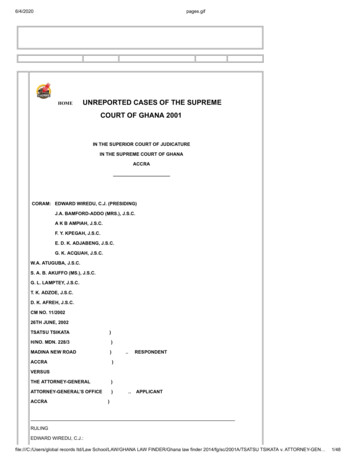
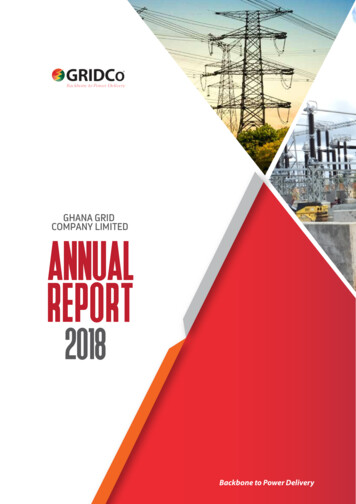
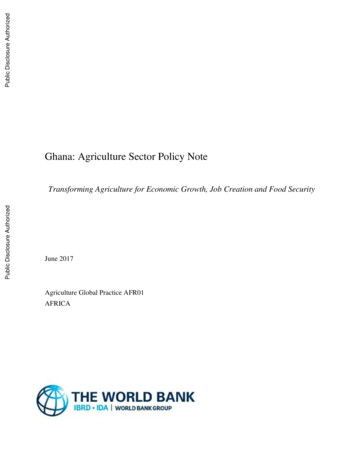
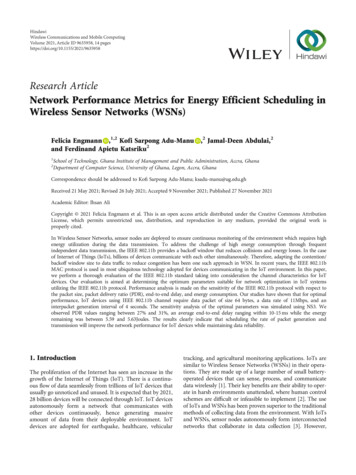
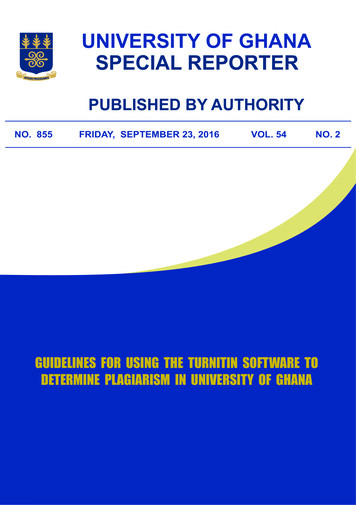
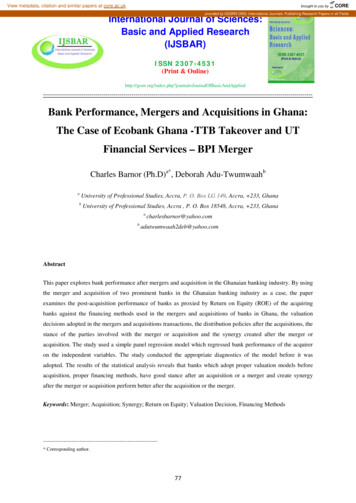

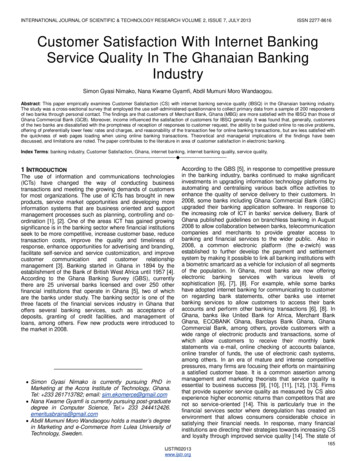
![Ghana Demographic and Health Survey 2014 [FR307]](/img/41/fr307.jpg)
